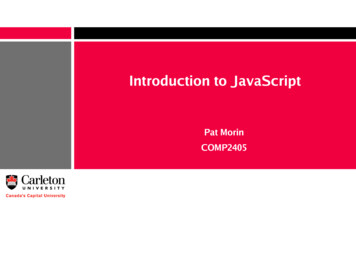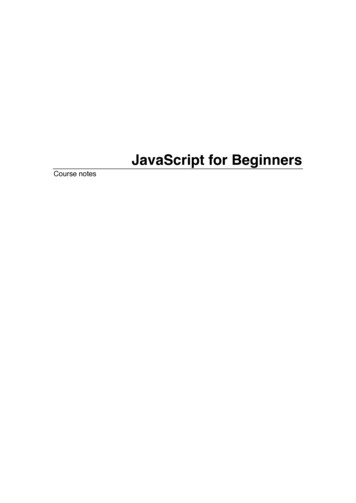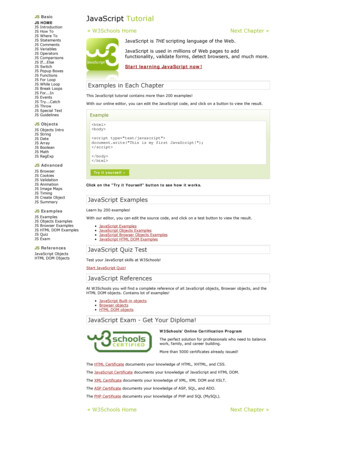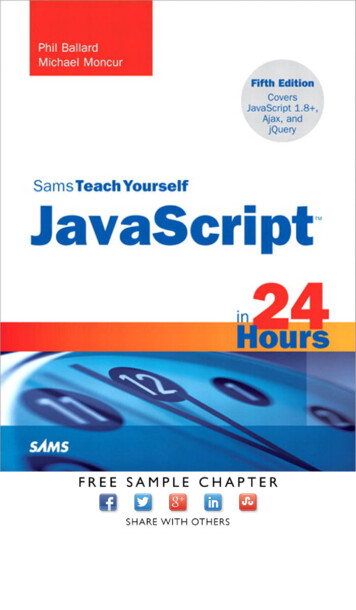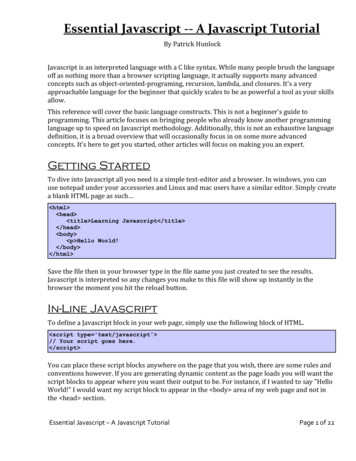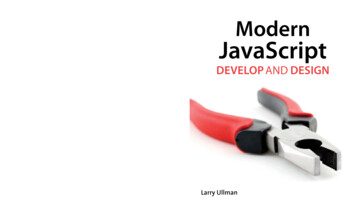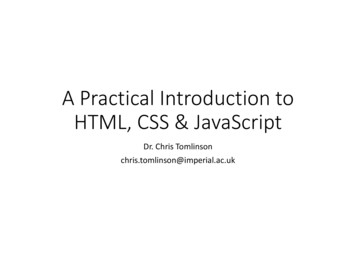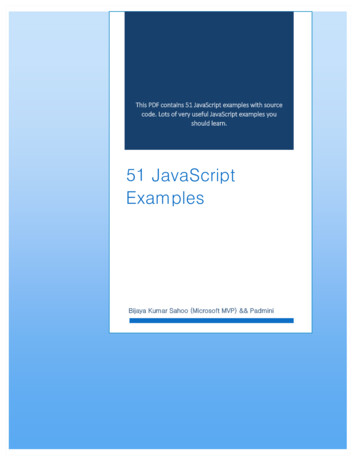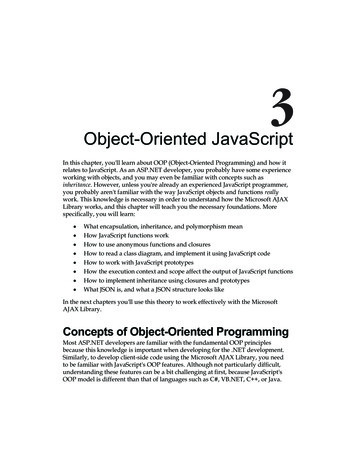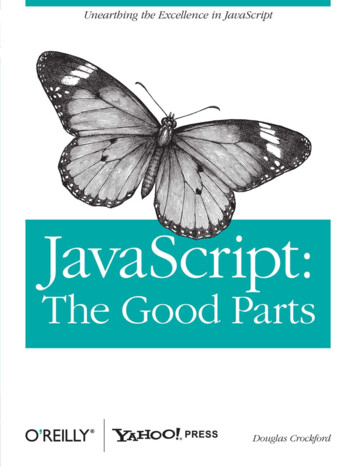
Transcription
JavaScript: The Good Parts
Other resources from O’ReillyRelated titlesoreilly.comHigh Performance Web SitesJavaScript and DHTMLCookbook JavaScript: The DefinitiveGuideLearning JavaScriptoreilly.com is more than a complete catalog of O’Reilly books.You’ll also find links to news, events, articles, weblogs, samplechapters, and code examples.oreillynet.com is the essential portal for developers interested inopen and emerging technologies, including new platforms, programming languages, and operating systems.ConferencesO’Reilly brings diverse innovators together to nurture the ideasthat spark revolutionary industries. We specialize in documenting the latest tools and systems, translating the innovator’sknowledge into useful skills for those in the trenches. Visitconferences.oreilly.com for our upcoming events.Safari Bookshelf (safari.oreilly.com) is the premier online reference library for programmers and IT professionals. Conductsearches across more than 1,000 books. Subscribers can zero inon answers to time-critical questions in a matter of seconds.Read the books on your Bookshelf from cover to cover or simply flip to the page you need. Try it today for free.
JavaScript: The Good PartsDouglas CrockfordBeijing Cambridge Farnham Köln Sebastopol Taipei Tokyo
JavaScript: The Good Partsby Douglas CrockfordCopyright 2008 Yahoo! Inc. All rights reserved.Printed in the United States of America.Published by O’Reilly Media, Inc., 1005 Gravenstein Highway North, Sebastopol, CA 95472.O’Reilly books may be purchased for educational, business, or sales promotional use. Online editionsare also available for most titles (safari.oreilly.com). For more information, contact ourcorporate/institutional sales department: (800) 998-9938 or corporate@oreilly.com.Editor: Simon St.LaurentProduction Editor: Sumita MukherjiCopyeditor: Genevieve d’EntremontProofreader: Sumita MukherjiIndexer: Julie HawksCover Designer: Karen MontgomeryInterior Designer: David FutatoIllustrator: Robert RomanoPrinting History:May 2008:First Edition.Nutshell Handbook, the Nutshell Handbook logo, and the O’Reilly logo are registered trademarks ofO’Reilly Media, Inc. JavaScript: The Good Parts, the image of a Plain Tiger butterfly, and related tradedress are trademarks of O’Reilly Media, Inc.Java is a trademark of Sun Microsystems, Inc.Many of the designations used by manufacturers and sellers to distinguish their products are claimed astrademarks. Where those designations appear in this book, and O’Reilly Media, Inc. was aware of atrademark claim, the designations have been printed in caps or initial caps.While every precaution has been taken in the preparation of this book, the publisher and author assumeno responsibility for errors or omissions, or for damages resulting from the use of the informationcontained herein.This book uses RepKover , a durable and flexible lay-flat binding.ISBN: 978-0-596-51774-8[M][7/08]
For the Lads: Clement, Philbert, Seymore, Stern,and, lest we forget, C. Twildo.
Table of ContentsPreface . . . . . . . . . . . . . . . . . . . . . . . . . . . . . . . . . . . . . . . . . . . . . . . . . . . . . . . . . . . . . . . . . xi1. Good Parts . . . . . . . . . . . . . . . . . . . . . . . . . . . . . . . . . . . . . . . . . . . . . . . . . . . . . . . . . 1Why JavaScript?Analyzing JavaScriptA Simple Testing Ground2342. Grammar . . . . . . . . . . . . . . . . . . . . . . . . . . . . . . . . . . . . . . . . . . . . . . . . . . . . . . . . . . sLiteralsFunctions5678101517193. Objects . . . . . . . . . . . . . . . . . . . . . . . . . . . . . . . . . . . . . . . . . . . . . . . . . . . . . . . . . . . 20Object nEnumerationDeleteGlobal Abatement202122222223242425vii
4. Functions . . . . . . . . . . . . . . . . . . . . . . . . . . . . . . . . . . . . . . . . . . . . . . . . . . . . . . . . . 26Function ObjectsFunction ng rryMemoization2627273131323234363740404243445. Inheritance . . . . . . . . . . . . . . . . . . . . . . . . . . . . . . . . . . . . . . . . . . . . . . . . . . . . . . . 46PseudoclassicalObject SpecifiersPrototypalFunctionalParts47505052556. Arrays . . . . . . . . . . . . . . . . . . . . . . . . . . . . . . . . . . . . . . . . . . . . . . . . . . . . . . . . . . . . 58Array ensions585960606162637. Regular Expressions . . . . . . . . . . . . . . . . . . . . . . . . . . . . . . . . . . . . . . . . . . . . . . . . 65An ExampleConstructionElementsviii Table of Contents667072
8. Methods . . . . . . . . . . . . . . . . . . . . . . . . . . . . . . . . . . . . . . . . . . . . . . . . . . . . . . . . . . 789. Style . . . . . . . . . . . . . . . . . . . . . . . . . . . . . . . . . . . . . . . . . . . . . . . . . . . . . . . . . . . . . 9410. Beautiful Features . . . . . . . . . . . . . . . . . . . . . . . . . . . . . . . . . . . . . . . . . . . . . . . . . 98Appendix A. Awful Parts . . . . . . . . . . . . . . . . . . . . . . . . . . . . . . . . . . . . . . . . . . . . . . . . 101Appendix B. Bad Parts . . . . . . . . . . . . . . . . . . . . . . . . . . . . . . . . . . . . . . . . . . . . . . . . . 109Appendix C. JSLint . . . . . . . . . . . . . . . . . . . . . . . . . . . . . . . . . . . . . . . . . . . . . . . . . . . . . 115Appendix D. Syntax Diagrams . . . . . . . . . . . . . . . . . . . . . . . . . . . . . . . . . . . . . . . . . . . 125Appendix E. JSON . . . . . . . . . . . . . . . . . . . . . . . . . . . . . . . . . . . . . . . . . . . . . . . . . . . . . . 136Index . . . . . . . . . . . . . . . . . . . . . . . . . . . . . . . . . . . . . . . . . . . . . . . . . . . . . . . . . . . . . . . . . 147Table of Contents ix
Preface1If we offend, it is with our good willThat you should think, we come not to offend,But with good will. To show our simple skill,That is the true beginning of our end.—William Shakespeare, A Midsummer Night’s DreamThis is a book about the JavaScript programming language. It is intended for programmers who, by happenstance or curiosity, are venturing into JavaScript for the firsttime. It is also intended for programmers who have been working with JavaScript at anovice level and are now ready for a more sophisticated relationship with the language. JavaScript is a surprisingly powerful language. Its unconventionality presentssome challenges, but being a small language, it is easily mastered.My goal here is to help you to learn to think in JavaScript. I will show you the components of the language and start you on the process of discovering the ways thosecomponents can be put together. This is not a reference book. It is not exhaustiveabout the language and its quirks. It doesn’t contain everything you’ll ever need toknow. That stuff you can easily find online. Instead, this book just contains thethings that are really important.This is not a book for beginners. Someday I hope to write a JavaScript: The FirstParts book, but this is not that book. This is not a book about Ajax or web programming. The focus is exclusively on JavaScript, which is just one of the languages theweb developer must master.This is not a book for dummies. This book is small, but it is dense. There is a lot ofmaterial packed into it. Don’t be discouraged if it takes multiple readings to get it.Your efforts will be rewarded.xi
Conventions Used in This BookThe following typographical conventions are used in this book:ItalicIndicates new terms, URLs, filenames, and file extensions.Constant widthIndicates computer coding in a broad sense. This includes commands, options,variables, attributes, keys, requests, functions, methods, types, classes, modules,properties, parameters, values, objects, events, event handlers, XML andXHTML tags, macros, and keywords.Constant width boldIndicates commands or other text that should be typed literally by the user.Using Code ExamplesThis book is here to help you get your job done. In general, you may use the code inthis book in your programs and documentation. You do not need to contact us forpermission. For example, writing a program that uses several chunks of code fromthis book does not require permission. Selling or distributing a CD-ROM of examples from O’Reilly books does require permission. Answering a question by citingthis book and quoting example code does not require permission. Incorporating asignificant amount of example code from this book into your product’s documentation does require permission.We appreciate, but do not require, attribution. An attribution usually includes thetitle, author, publisher, and ISBN. For example: “JavaScript: The Good Parts by Douglas Crockford. Copyright 2008 Yahoo! Inc., 978-0-596-51774-8.”If you feel your use of code examples falls outside fair use or the permission givenhere, feel free to contact us at permissions@oreilly.com.Safari Books OnlineWhen you see a Safari Books Online icon on the cover of yourfavorite technology book, that means the book is available onlinethrough the O’Reilly Network Safari Bookshelf.Safari offers a solution that’s better than e-books. It’s a virtual library that lets youeasily search thousands of top tech books, cut and paste code samples, downloadchapters, and find quick answers when you need the most accurate, current information. Try it for free at http://safari.oreilly.com.xii Preface
How to Contact UsPlease address comments and questions concerning this book to the publisher:O’Reilly Media, Inc.1005 Gravenstein Highway NorthSebastopol, CA 95472800-998-9938 (in the United States or Canada)707-829-0515 (international or local)707-829-0104 (fax)We have a web page for this book, where we list errata, examples, and any additional information. You can access this page at:http://www.oreilly.com/catalog/9780596517748/To comment or ask technical questions about this book, send email to:bookquestions@oreilly.comFor more information about our books, conferences, Resource Centers, and theO’Reilly Network, see our web site at:http://www.oreilly.com/AcknowledgmentsI want to thank the reviewers who pointed out my many egregious errors. There arefew things better in life than having really smart people point out your blunders. It iseven better when they do it before you go public. Thank you, Steve Souders, BillScott, Julien Lecomte, Stoyan Stefanov, Eric Miraglia, and Elliotte Rusty Harold.I want to thank the people I worked with at Electric Communities and State Software who helped me discover that deep down there was goodness in this language,especially Chip Morningstar, Randy Farmer, John La, Mark Miller, Scott Shattuck,and Bill Edney.I want to thank Yahoo! Inc. for giving me time to work on this project and for beingsuch a great place to work, and thanks to all members of the Ajax Strike Force, pastand present. I also want to thank O’Reilly Media, Inc., particularly Mary Treseler,Simon St.Laurent, and Sumita Mukherji for making things go so smoothly.Special thanks to Professor Lisa Drake for all those things she does. And I want tothank the guys in ECMA TC39 who are struggling to make ECMAScript a betterlanguage.Finally, thanks to Brendan Eich, the world’s most misunderstood programming language designer, without whom this book would not have been necessary.Preface xiii
Chapter 1CHAPTER 1Good Parts1 setting the attractions of mygood parts aside I have no other charms.—William Shakespeare, The Merry Wives of WindsorWhen I was a young journeyman programmer, I would learn about every feature ofthe languages I was using, and I would attempt to use all of those features when Iwrote. I suppose it was a way of showing off, and I suppose it worked because I wasthe guy you went to if you wanted to know how to use a particular feature.Eventually I figured out that some of those features were more trouble than theywere worth. Some of them were poorly specified, and so were more likely to causeportability problems. Some resulted in code that was difficult to read or modify. Someinduced me to write in a manner that was too tricky and error-prone. And some ofthose features were design errors. Sometimes language designers make mistakes.Most programming languages contain good parts and bad parts. I discovered that Icould be a better programmer by using only the good parts and avoiding the badparts. After all, how can you build something good out of bad parts?It is rarely possible for standards committees to remove imperfections from a language because doing so would cause the breakage of all of the bad programs thatdepend on those bad parts. They are usually powerless to do anything except heapmore features on top of the existing pile of imperfections. And the new features donot always interact harmoniously, thus producing more bad parts.But you have the power to define your own subset. You can write better programs byrelying exclusively on the good parts.JavaScript is a language with more than its share of bad parts. It went from nonexistence to global adoption in an alarmingly short period of time. It never had aninterval in the lab when it could be tried out and polished. It went straight intoNetscape Navigator 2 just as it was, and it was very rough. When Java appletsfailed, JavaScript became the “Language of the Web” by default. JavaScript’s popularity is almost completely independent of its qualities as a programming language.1
Fortunately, JavaScript has some extraordinarily good parts. In JavaScript, there is abeautiful, elegant, highly expressive language that is buried under a steaming pile ofgood intentions and blunders. The best nature of JavaScript is so effectively hiddenthat for many years the prevailing opinion of JavaScript was that it was an unsightly,incompetent toy. My intention here is to expose the goodness in JavaScript, an outstanding
This is a book about the JavaScript programming language. It is intended for pro-grammers who, by happenstance or curiosity, are venturing into JavaScript for the first time. It is also intended for programmers who have been working with JavaScript at a novice level and are now ready for a more sophisticated relationship with the lan-guage. JavaScript is a surprisingly powerful language. Its
